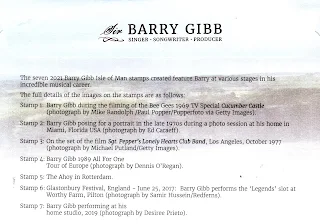PITCAIRN ISLAND via Bounty Post on 30 March 2017 issued a series of first day cover stamps dedicated to the Women of Pitcairn. Three stamps of various denomination (from NZ$1.80, NZ$2.20 to NZ$2.80) were released. The stamps depict and list the names of the 12 Polynesian women and a baby girl who left Tahiti with the crew of the Bounty. One of the activities they maintained on Pitcairn was the weaving tapa which is shown as well in these stamps. Shown here is the souvenir sheet in this FDC set.
The souvenir sheet was purchased directly from Pitcairn Island. It was literary shipped aboard the island's monthly mail ship and delivered to New Zealand where it was dispatched to my residence in Malaysia. It was sent by Mike and Brenda Christian, presumably descendants of Fletcher Christian.
In September 1789, after the mutiny and while staying briefly on Tahiti, Fletcher Christian became concerned that some of his men were ready to rebel against him. Spurred also by fear of discovery and arrest from Britain, he made a hurried departure. He and eight members of the Bounty crew sailed from Tahiti with six Polynesian men, 12 Polynesian women and a baby girl.
Searching for a new home took four months until uncharted Pitcairn was sighted on 15 January 1790. A decision was made on 23 January to burn the Bounty and the fate of all to remain on the island was sealed. The women consorts soon adopted a survival mode by growing crops, fishing, making tapa for warmth and clothing and ensuring Tahitian culture remained an integral part of Pitcairn's identity through music and dance.
Pauline Reynolds in her "Textile History" article* writes how the production of tapa and gifting "reveals information regarding their social, ritual and innovative activities, and their contribution to the Bounty/Pitcairn story". This activity was exclusively a female role but one that gave them a degree of power, status and prestige (depending on the fineness of the cloth). It also provided an outlet for their creative talents and helped bind social relationships.
Reynolds added, "The making and felting of cloth by the women of the Pitcairn community was symbolic of the binding and weaving of relationships, particularly amongst the women and their children". Their innovative designs and experimentation led to unique Pitcairn tapa cloths which are different to those from Tahiti (French Polynesia) and very recognisable today. Reynolds concluded that the Bounty women were "active agents in their community, playing a dynamic role in shaping the social landscape".
Designer: Lucas Kukler, Bangkok, Thailand.
Printer: Southern Colour Print, Dunedin, New Zealand
Process: Offset Litho
Stamp size: 40.0 mm x 30.0 mm vertical.
Format: Miniature sheet containing 3 vertical stamps
Perforation Gauge: 13.33 x 13.60
Denominations: NZ$1.80, NZ$2.20 and NZ$2.80
Paper: 106gsm Tullis Russell Red phosphor stamp paper.
Period of Sale: 30 March 2017 for a period of 2 years.
*Source: Tapa Cloths and Beaters: Tradition, Innovation and the Agency of the Bounty Women in Shaping a New Culture on Pitcairn Island from 1790 to 1850. - Pauline Reynolds, 2016.



















